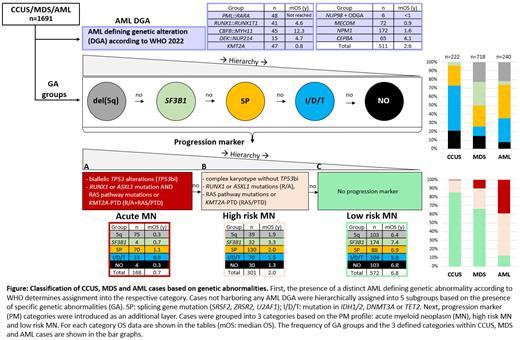Background: According to the 5 th edition of the WHO classification (WHO 2022) and the International Consensus Classification (ICC) the main parameters used for the definition of CCUS, MDS and AML are cytopenias, dysplasia, blast count and distinct genetic abnormalities. These entities represent a disease continuum as CCUS can progress to MDS and MDS to AML. Thus, we asked the question whether this continuum can be reflected in a proposed comprehensive classification system.
Methods: We evaluated 222 CCUS, 718 de novo MDS and 751 de novo AML. The diagnosis was established following WHO 2022. Bone marrow samples were analyzed by cytomorphology, chromosome banding analysis, targeted NGS panel sequencing (median coverage 1500x) and WGS (median coverage 100x). Overall survival (OS) was available for 1552/1691 patients. Median follow-up with respect to OS was CCUS: 1.7 years, MDS: 9.3 years, AML: 6.7 years.
Results: In the WHO 2022 classification a subset of AML entities (AML with defining genetic abnormalities (DGA)) is defined by fusions ( PML:: RARA, RUNX1:: RUNX1T1, CBFB:: MYH11, DEK:: NUP214, RBM15:: MRTFA other defined genetic alterations/ ODGA), rearrangements ( KMT2A, NUP98, MECOM) and distinct mutations ( NPM1, CEBPA). These well-established distinct entities were kept in the classification proposal. 511 AML cases (67%) were classified as AML DGA (Figure 1). The remaining 240 AML cases classified as AML myelodysplasia-related and AML defined by differentiation according to WHO 2022 were combined with MDS and CCUS cases and categorized hierarchically into 5 distinct groups based on the presence of the following genetic abnormalities (GA group): 1. 5q deletion, 2. SF3B1 mutation, 3. other spliceosome mutations (SP: SRSF2, U2AF1, ZRSR2), 4. IDH1/2 or DNMT3A or TET2 mutations (I/D/T), 5. None of these (NO) (Figure 1). Next, within these GA groups the presence of progression markers (PM) was evaluated: PM subset A: presence of a) biallelic TP53 alterations ( TP53bi), or b) mutations in RUNX1 or ASXL1 and mutations in RAS pathway genes or KMT2A-PTD (R/A+RAS/PTD); PM subset B: presence of a) complex karyotype without TP53bi (complex), or b) RUNX1,or ASXL1 mutations (R/A), or RAS pathway mutations or KMT2A-PTD (RAS/PTD); PM subset C: absence of these PM. The assignment into GA groups and PM subsets differed substantially between CCUS, MDS and AML. With respect to GA group CCUS, MDS and AML cases were assigned into GA groups del(5q): CCUS (0%), MDS (76%), AML (24%); SF3B1: CCUS (4%), MDS (91%), AML (5%); SP: CCUS (16%), MDS (55%), AML (29%); I/D/T: CCUS (45%), MDS (30%), AML (25%); NO: CCUS (27%), MDS (62%), AML (11%). With respect to PM subsets CCUS, MDS and AML cases were assigned into A: CCUS (1%), MDS (43%), AML (56%); B: CCUS (10%), MDS (54%), AML (36%); C: CCUS (27%), MDS (69%), AML (4%) (Figure 1). Next, OS was evaluated. Median OS for PM subsets A (n=168), B (n=301) and C (n=572) was 0.7, 2.0 and 6.8 years ( p<0.001), respectively and thus were named acute myeloid neoplasm (MN), high risk MN and low risk MN. Median OS in years in each GA group in acute MN was del(5q): 0.3, SF3B1: 0.7, SP: 1.1, I/D/T: 0.9 and NO: 0.3. The respective data for high risk and low risk MN were: 1.9, 3.3, 2.0, 1.5, 1.3 and 6.4, 7.4, 6.9, 5.8, and 6.8 years (Figure 1).
Conclusions: The proposed classification aims at reflecting the biological continuum of CCUS, MDS and AML and allows reclassification during the course of the disease without changing the disease entity following the concept of MPN with chronic phase and blast phase. Further, the classification reflects prognosis and also directly indicates potential therapeutic targets. It is flexible as new genetic markers can easily be added without changing the overall concept.
Disclosures
Haferlach:MLL Munich Leukemia Laboratory: Current Employment, Other: Equity Ownership. Huber:MLL Munich Leukemia Laboratory: Current Employment. Baer:MLL Munich Leukemia Laboratory: Current Employment. Hutter:MLL Munich Leukemia Laboratory: Current Employment. Meggendorfer:MLL Munich Leukemia Laboratory: Current Employment. Kern:MLL Munich Leukemia Laboratory: Current Employment, Other: Equity Ownership. Hoermann:MLL Munich Leukemia Laboratory: Current Employment. Haferlach:MLL Munich Leukemia Laboratory: Current Employment, Other: Equity Ownership.


This feature is available to Subscribers Only
Sign In or Create an Account Close Modal